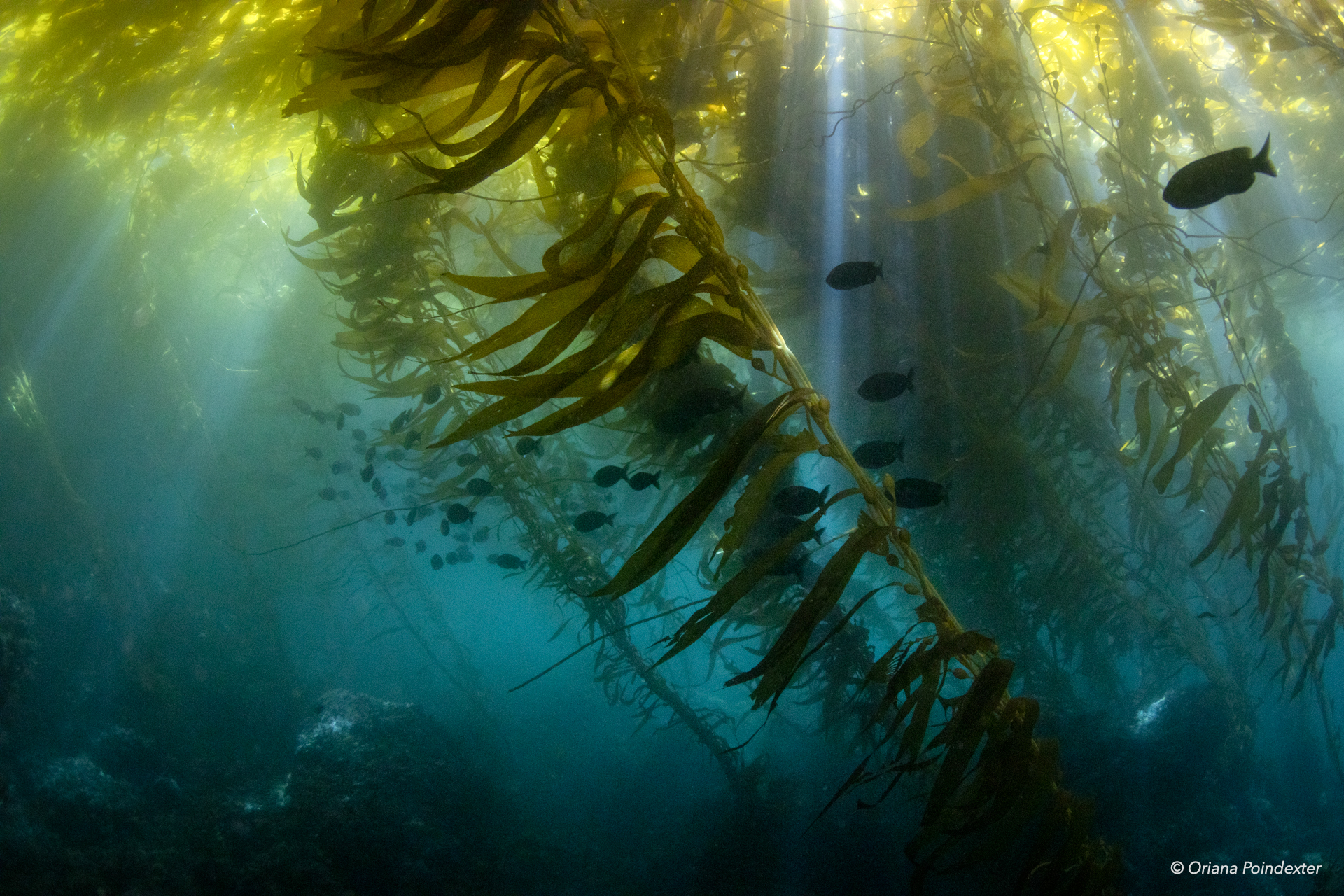
Diving into Abalone Habitat: Channel Islands National Marine Sanctuary
By: Oriana Poindexter, Founder & Principal, Pelagic Projects
This blog is the third in a series, The Iridescent Ones: Visualizing California’s Abalone. Read part one of this blog series, Extreme Tidepooling for Black Abalone on California’s Central Coast, in which Oriana goes searching for black abalone. Part two of this blog series, Scuba Diving for White Abalone at the “Hotspot”, discusses Oriana’s search for white abalone. Part four of this blog series, Into the Wild: Exhibit Creation with the Aquarium of the Pacific, introduces Oriana’s new exhibit showcasing the abalone.
The day dawns bright and clear, unexpectedly but thankfully so. On a mid-April morning in Ventura, my dive buddy, Huntley, and I are taking a bit of a gamble by boarding the Spectre, a day-trip passenger dive vessel. We are headed, finally, to Channel Islands National Marine Sanctuary (CINMS) for a day of diving in what was historically known as prime abalone territory.
I’ve been conducting research for over a year at this point to inform an upcoming book about California’s abalone (Haliotis spp), their habitats, and the science that supports them, but had yet to literally dive into these waters as part of my work. This work is a partnership with the National Marine Sanctuary Foundation, the education & outreach staff at CINMS, and abalone scientists and managers at the National Oceanic & Atmospheric Administration (NOAA).
Historically, all seven abalone species native to California lived in the waters surrounding the Channel Islands. The geographic ranges of California’s seven abalone species overlap in the Southern California Bight, with Point Conception marking the northern boundary of the range for white, pink, and green abalone, and the other species extending south at least to the border with Baja California. In the context of abalone harvesting, this region was once the promised land. A significant portion of the commercial landings of white, pink, green, and black abalone post-1950 were picked from the waters around the Islands.
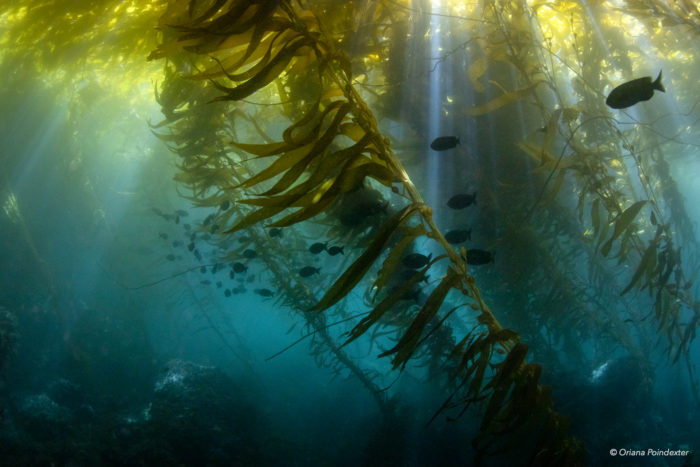
A view from inside the giant kelp forest of Anacapa Island in Channel Island National Marine Sanctuary waters. Credit: Oriana Poindexter
These days, a group of vessels in the Ventura, Oxnard, and Santa Barbara area serve the recreational diving community, providing short trips for thousands of divers per year to the Channel Islands to experience the waters of the Sanctuary. In coordination with CINMS, I’ve been assisting in the development of a public-facing initiative that would harness the many sets of eyes belonging to the recreational divers that frequent these waters to gather information about the abalone living there.
We are building a suite of educational materials for the recreational diving community to help recreational divers learn to identify different species of abalone. The ultimate goal is for someone to spot a living white abalone (H. sorenseni) in the waters of the Sanctuary or the California Bight, recognize the animal, photograph it, record its location, and report the sighting to scientists. White abalone were reported in high densities in the Channel Islands in the 1970’s at depths between 25 and 65 meters, but had all but disappeared by the 1990s.
CINMS is preparing for the launch of the Wanted Alive: White Abalone campaign in June 2021. Housed on a new web portal, FindingHal.org, the campaign will include an educational poster about endangered white abalone to be displayed at dive shops and aboard dive boats, a multi-species underwater reference card, and an online portal for citizen-scientist divers to report their sightings. I am contributing a set of detailed, top-side abalone ID cards for each species, so that divers can confirm which species of abalone they found.
Boarding the Spectre on this mid-April morning is a gamble for two reasons. First, as one of about 30 passengers, I have no say over exactly where the Spectre would drop us off to dive. Abalone are generally found on rocky reefs near kelp beds, but given their propensity for camouflage and cryptic behavior, finding them can be a challenge. What appears to be a perfectly hospitable, beautiful kelp forest with rocky substrate may hold zero abalone, while a sparse area 500 yards away could be chock full.
Second, as the captain reminds us several times via loudspeaker on the crossing, the conditions here in April can range from decent to decidedly unpleasant, both above and below the surface. Spring in the Southern California Bight is historically a season of upwelling, a wind-driven process that results in cold water temperatures and poor visibility. When wind blows parallel to the coast, it pushes the warm surface layer of water out to sea, allowing cold, nutrient rich water from below to rise to the surface to take its place.

The Spectre rounds Anacapa Island’s iconic Arch Rock, in Channel Island National Marine Sanctuary waters. Credit: Oriana Poindexter
To a diver, ‘nutrient rich’ means pea soup – cold water full of nutrients, plankton, particulates, and chlorophyll is green, thick, and full of life. It’s a great thing for marine life, but cold, green water has been known to cause whining in divers and surfers. Climate variability in recent years has thrown a wrench into all of this, making it much more difficult to predict anything, including seasonal upwelling. Worst case, I figure, we’ll find no abalone, barely be able to see our own fins, freeze, and get rained on. I set my expectations low, fingers crossed behind my back.
After a smooth, sunny crossing, I start daring to think that we might get lucky. We arrive at our first dive site, a cove on the frontside of Anacapa Island within the protected waters of the Sanctuary. It looks like a spot that pink (H. corrugata) or green abalone (H. fulgens) might comfortably choose to call home.
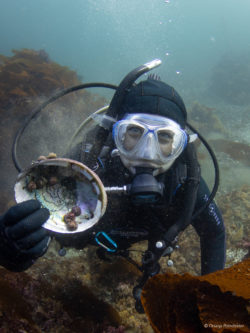
My dive buddy, Huntley Penniman, holds a green abalone shell she found on our first dive of the day. Credit: Oriana Poindexter
I descend slowly into the dive with my buddy, a bit distracted as I check my camera settings. I nearly land on top of a pink abalone shell as I reach the bottom. My heart rate spikes as I snap a photo of the shell – this must be a good sign! Our first dive turns up several more pink abalone shells, all which appear to have been dead for some time, but no living abalone. One of the shells we find sports a wire washer tag, which I later learn means it is likely evidence of a relocation study done in the vicinity in the 1990’s.
Our second dive is in a dense bed of giant kelp (Macrocystis pyrifera) on the seaward side of the island. This dive in the kelp forest is otherworldly, despite some surge creating less-than-perfect conditions. Hidden in the forest is a large underwater rock arch that divers can easily swim under, light beaming through the kelp blades. Despite the distinct sense of wonder imparted by the environment, we emerge from the dive a bit discouraged, encountering just a single fragment of abalone shell in nearly an hour of diving. Sections of the reef hold large aggregations of purple sea urchins (Strongylocentrotus purpuratus), munching away at the kelp and producing patchy clearings in the forest.
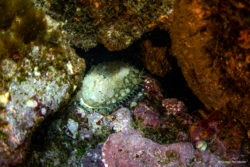
Bingo! A living green abalone hidden deep in a crevice between large boulders. You can see the animal’s fringed epipodium and tentacles below the edge of the thickly encrusted shell. Credit: Oriana Poindexter
Our third and final dive has to be the charm. Back on the protected side within Sanctuary waters, we eagerly jump in, our mission urgent. This site is full of large boulders with deep crevices between them, lush with a diverse, colorful array of nearly psychedelic understory algal species. Just a few minutes into the dive, I catch a glimpse of my first live abalone of the day – a green abalone, hidden deep in a dark crevice between boulders. I breathe a huge, bubbly sigh of relief through my regulator. This site reveals a handful of living green abalone, each tucked deep down between large boulders, and a few shells.
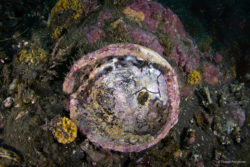
An old, heavily encrusted pink abalone shell found on our second dive of the day. Credit: Oriana Poindexter
We surface, relieved and smiling. On the crossing back to the California mainland, I share a few prototypes of my abalone species ID cards with the Spectre’s divemaster. Chuck takes an interest, and provides some ideas to make the cards most useful to the type of diver on this trip, but the look on his face is wistful, nostalgic. It’s a look that I am getting familiar with, as I see it time and time again when talking to older divers about abalone. It’s a look of memories brimming to the surface, and hopefully, a look that holds a kernel of hope that those experiences might be possible again in the future.
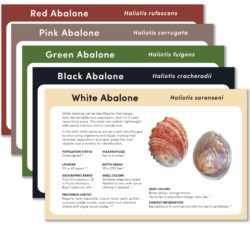
Abalone Species ID Guides for white, black, red, pink and green abalone are now available for digital download.
Read more about white, black, and red abalone in The Iridescent Ones blog series here.
Download your own set of Abalone ID guides here or by clicking the image to the right.
To learn more about Channel Islands National Marine Sanctuary and the Wanted Alive campaign, visit their website. Learn more about endangered white abalone research and conservation efforts at NOAA Fisheries.
Thank you to the National Marine Sanctuary Foundation for continued support of this work.
Oriana Poindexter is a marine scientist and artist. Her work is interdisciplinary and focuses on the intersection of marine science, art, and food. She is a Visiting Scientist affiliated with the NOAA Southwest Fisheries Science Center, a Senior Fisheries Fellow at the Scripps Institution of Oceanography (SIO), and the founder of Pelagic Projects, LLC. When she escapes her computer, she can be found diving, surfing, or eating seafood. The Iridescent Ones is a collaboration funded by the National Marine Sanctuary Foundation, with support from the Channel Islands National Marine Sanctuary and NOAA Fisheries. Learn more about her work at: http://www.orianapoindexter.com/.
